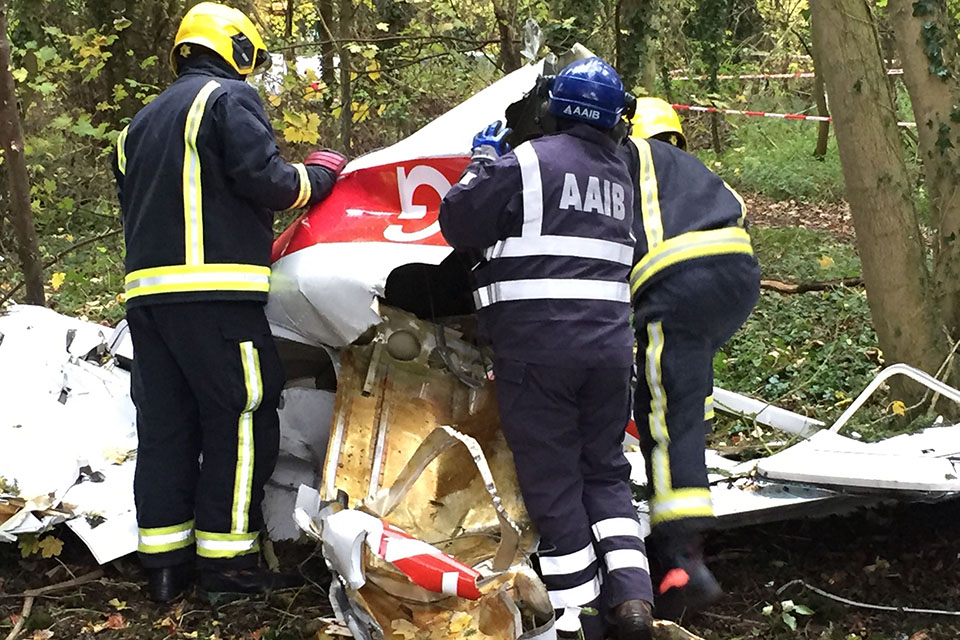AAIB Briefing Note for the Emergency Services
Published 19 September 2018
Information
We investigate civil aircraft accidents and serious incidents in the United Kingdom.
TO REPORT AN AIRCRAFT ACCIDENT or SERIOUS INCIDENT
Telephone 01252 512299 (24 Hours)
Major Incident declared?
Send a copy of your M/ETHANE to: Investigations@aaib.gov.uk
Intent
We improve aviation safety by determining the circumstances and causes of air accidents and serious incidents, and promoting action to prevent reoccurrence.
We are a “stand-alone” branch of the Department for Transport and are completely separate from the Civil Aviation Authority. The Chief Inspector of Air Accidents is responsible directly to the Secretary of State for Transport.
We are responsible for ensuring that the UK complies with its national and international statutory obligations for air accident investigation.
WE DO NOT APPORTION BLAME OR LIABILITY.

AAIB working alongside the emergency services
Method
We will deploy a team, organising our response in relation to the seriousness of the accident or incident.
For major aviation disasters, an AAIB Principal Inspector will lead the team as the Investigator in Charge (IiC) at Tactical level, with the Chief Inspector being contactable through AAIB HQ at Strategic level.
For fatal general aviation accidents or serious incidents involving commercial air transport, we will deploy a smaller team.
Our powers originate from the Civil Aviation Act and include:
● To have free access to the site of the accident or incident as well as to the aircraft, its contents or its wreckage.
● To ensure an immediate listing of evidence and controlled removal of debris, or components for examination or analysis purposes.
● To take such measures for the preservation of evidence as appropriate.
● To have immediate access to and use of the contents of the flight recorders and any other recordings.
● To take statements from all such persons as we think fit and to require any such person to make and sign a declaration of the truth of the statement made by them.
We have MoUs in place with the Police and other agencies to clarify these procedures.
Administration
Initial actions:
● An aircraft accident or serious incident must be reported using our 24 hour number, 01252 512299. Our duty coordinator will then make arrangements to deploy a team of inspectors and can be contacted 24/7 to provide advice.
● Extremities of the accident site should be identified as soon as possible and sealed off. Only those required for rescue should be permitted access.
● We will cooperate with the Police and other agencies who may be required to conduct a parallel investigation.
● Evidence should be preserved, as far as possible, until an AAIB Inspector arrives.
● A key source of information will be electronic equipment (aircraft and personal) and data from cockpit voice and flight data recorders (‘black boxes’).
Electronic equipment: leave it alone
● Moisture, static damage, corrosion and inadvertent operation of electronic equipment can disrupt stored data. Sealed evidence bags trap moisture and are a hazard to electronic components. Plastic bags can build a static charge which may be disruptive. The oxygen in the air is a major accelerant of corrosion and electronic items that have been submersed in water should be kept submersed and advice sought from the AAIB.
Photography/Filming
● Images or media, particularly in the early stages of the emergency response, may be useful to aid the understanding of disruption to key sources of evidence such as the cutting of aircraft wreckage to free occupants. Copies of these images/videos should be made available to AAIB personnel at the earliest opportunity.
See the ‘Communications’ section below before releasing any images or posting on social media.
Risk Assessment
You can seek our advice or ask for guidance on aircraft hazards at any time. Once on site, we will carry out our own risk assessments and will share this information with all agencies working in the vicinity of the wreckage.
Early guidance on accident site hazards:
● Flammable substances. Fuel is the primary hazard in most accidents. Aviation gasoline (AVGAS) for piston engines and Aviation Turbine Fuel (AVTUR) for jet or turbo-prop aircraft.
● Electrical systems. Aircraft batteries and emergency power supplies pose an ignition threat.
● Damaged structures. Sharp/jagged edges and damaged composite materials can create serious puncture wounds and damage to flesh.
● Pressurised systems and containers. Not always easily identifiable, these can exert extreme force if disturbed. These systems can be pressurised gases/fluids/powders or mechanical springs/dampers. Sudden release can cause severe injury or increased risk/ acceleration of fire. Pressure in aircraft tyres may be harmful if disturbed.
● Aircraft escape systems. Military and ex military aircraft may have ejection seats fitted together with explosive canopies and jettison systems. Extreme care should be taken in these instances and advice should be sought from suitably trained personnel.
● Ballistic Recovery Systems (BRS). Often referred to as ballistic parachutes, these are a safety device fitted to some light aircraft. They contain a rocket. An un-deployed system poses a severe threat to rescuers and responders.
● Cartridge initiated devices (to activate systems such as fire extinguishers and escape slides). The cartridge device itself is low risk, however, the inadvertent operation of the system it controls poses a more significant hazard.
● Fire damaged materials. Produce harmful gases, vapours and particles once damaged. For example, aluminium (aircraft structure), magnesium (aircraft components) and composite materials (modern aircraft structures can produce irritant free fibres which are hazardous if inhaled).
Communications
Emergency services should contact the AAIB head of external communications (01252 531511) before releasing or making a statement to the media.
● Emergency services explain their involvement, eg resources deployed and if they are working on behalf of the Coroner/Procurator Fiscal.
● Avoid the term ‘joint investigation’. ‘Assisting’ or ‘working with’ may be appropriate. If emergency services are conducting their own investigation, make clear that this is separate to the AAIB’s investigation.
● Images on social media must never include aircraft registrations (eg G-XXXX), as these are on a public website and those involved could be identified.
● We will explain our role in conducting a safety investigation and may include information such as the aircraft type. Where an aircraft type is rare, we will not release this information if the accident is fatal and the next of kin have not yet been reached.
Media enquiries:
01252 531511 (office hrs)
020 7944 4292 (other times)
General enquiries:
01252 510300 (0830-1700hrs Monday to Friday)
Email:
enquiries@aaib.gov.uk (not 24 hrs)
Humanitarian issues
Passengers are an important source of evidence. We have a passenger questionnaire in online and printable formats at https://www.gov.uk/government/ publications/aaib-passenger-questionnaire. Using this questionnaire helps us to gather evidence. Where a reception centre is set up by the airline or local authority, emergency services should ensure that accurate records are being kept of names, addresses and (if known) aircraft seat allocation.
If a media facility is set up, this should not be in the same location as a reception centre for survivors and relatives.

